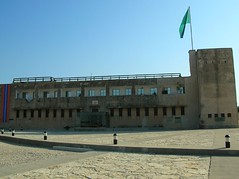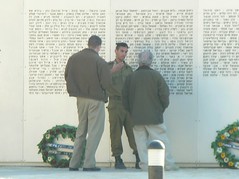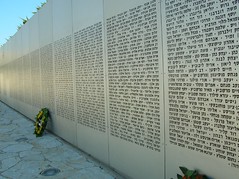Saturday, December 23, 2006
Tanks for the memories
The Armored Corps Museum at Latrun
Latrun is a hilltop town halfway between Tel Aviv and Jerusalem. Because of its strategic location, commanding what at one time was the only road to Jerusalem from the main Mediterranean port at Jaffa (next to Tel Aviv), the British built a fortified police station there in the 1930s as part of its occupation of Palestine. When they withdrew in 1947, the Latrun fort was taken over by the Jordanian army from which vantage point it cut the road to Jerusalem during the Israeli War of Independence in 1948.
So strategically important was Latrun that the Israelis launched three separate assaults against the fort, ultimately failing to take it after suffering heavy casualties. Instead, they were only able to relieve the seige of Jerusalem by building a new road, dubbed the Burma Road, which was protected by hills from the guns at the Latrun fort. Latrun ultimately fell into Israeli hands only during the Six Day War in 1967.
Now the Latrun fort is the home of a small military installation, as well as the Armored Corps Museum. This museum has 120 tanks and armored fighting vehicles on display, the largest collection of its kind in the world. I took advantage of the fact that I'm traveling alone by looking at, I'm pretty sure, every one of them. It was two hours well spent.
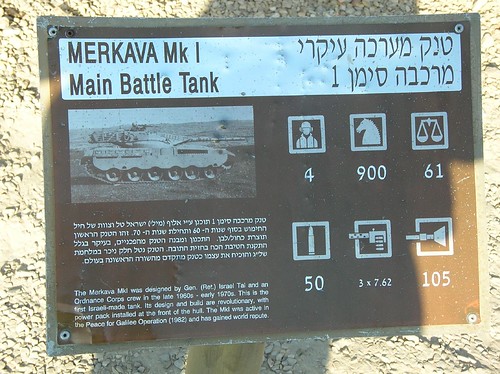
Each tank had an extremely informative identifying plaque, like this.

I love this artifiact of war surplus. An early vietnam-era tank gets mothballed
by the U.S. army and sent to "Isreal."
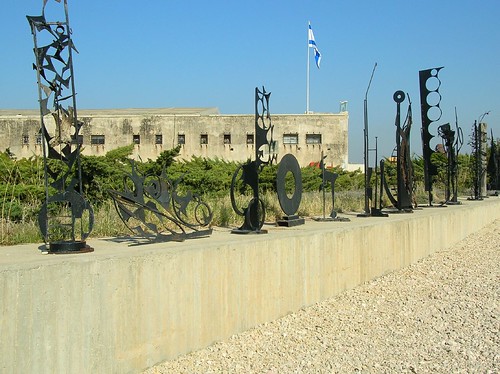
Swords into plowshares: you have to love a military museum that exhibits sculptures
made from scrap armor plating and tank parts.

Swords into bird roosts. This WWII era Sherman Tank sits atop a high pedestal,
which I guess makes it attractive to birds.
Latrun is a hilltop town halfway between Tel Aviv and Jerusalem. Because of its strategic location, commanding what at one time was the only road to Jerusalem from the main Mediterranean port at Jaffa (next to Tel Aviv), the British built a fortified police station there in the 1930s as part of its occupation of Palestine. When they withdrew in 1947, the Latrun fort was taken over by the Jordanian army from which vantage point it cut the road to Jerusalem during the Israeli War of Independence in 1948.
So strategically important was Latrun that the Israelis launched three separate assaults against the fort, ultimately failing to take it after suffering heavy casualties. Instead, they were only able to relieve the seige of Jerusalem by building a new road, dubbed the Burma Road, which was protected by hills from the guns at the Latrun fort. Latrun ultimately fell into Israeli hands only during the Six Day War in 1967.
The "Wall of Memory," with names of Israeli soldiers killed in the nation's wars.
Now the Latrun fort is the home of a small military installation, as well as the Armored Corps Museum. This museum has 120 tanks and armored fighting vehicles on display, the largest collection of its kind in the world. I took advantage of the fact that I'm traveling alone by looking at, I'm pretty sure, every one of them. It was two hours well spent.

Each tank had an extremely informative identifying plaque, like this.

I love this artifiact of war surplus. An early vietnam-era tank gets mothballed
by the U.S. army and sent to "Isreal."

Swords into plowshares: you have to love a military museum that exhibits sculptures
made from scrap armor plating and tank parts.

Swords into bird roosts. This WWII era Sherman Tank sits atop a high pedestal,
which I guess makes it attractive to birds.
Labels: travel
Comments:
<< Home
That plaque with the icons and numbers under it remind me a lot of wargame pieces. Which I suppose makes sense in a way.
Post a Comment
Subscribe to Post Comments [Atom]
<< Home
Subscribe to Comments [Atom]

